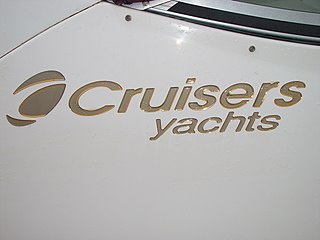
A boat is a watercraft of a large range of types and sizes, but generally smaller than a ship, which is distinguished by its larger size, shape, cargo or passenger capacity, or its ability to carry boats.

A runabout is any small motorboat holding between four and eight people, well suited to moving about on the water. Characteristically between 20' to 35' in length, runabouts are used for pleasure activities like boating, fishing, and water skiing, as a ship's tender for larger vessels, or in racing. Some common runabout types are bow rider, center console, cuddy boat and walkaround.

A motorboat, speedboat or powerboat is a boat that is exclusively powered by an engine.

The word Drascombe is a trademark that was first registered by John Watkinson who applied it to a series of sailing boats which he designed and built in the period 1965–79 and sold in the United Kingdom (UK). They comprised the Coaster, Cruiser Longboat, Dabber, Drifter, Driver, Gig, Launch, Longboat, Lugger, Peterboat, Scaffie, Scaith and Skiff, together with a few other one-offs. They have wide and deep cockpits, adaptable boomless rigs and high bulwarks.
Carver was a yacht builder located in Pulaski, Wisconsin in the United States.
From its inception in the late 1940s through about 1984, Wacanda Marine, Inc. was owned and operated by Forrest Collins, Colville, Washington. From 1984 to 1988, the company was owned by the Yakima Indian Nation, Wapato, Washington, although Mr. Collins managed the production
Stephens Brothers Boat Builders and Designers company, an American boat designer, began in the back yard of brothers Theodore and Robert Stephens. Their boatbuilding firm in Stockton, California operated from 1902 to 1987. Over the years the company became famous for its elegantly designed pleasure craft, including sailboats, speedboats, cruisers and private yachts. Stephens Bros. also built many vessels for the U.S. military, especially during World War II. The company's first vessel was the sloop Dorothy, in 1902.

Cruisers Yachts is a brand of pleasure boats owned by MarineMax. The company builds boats ranging from 33 feet - 60 feet, and is headquartered in Oconto, Wisconsin. The company was one of the first boat builders to utilize the Volvo Penta IPS propulsion system.
The Dolphin 24 is an American trailerable sailboat that was designed by William Shaw of Sparkman & Stephens as a Midget Ocean Racing Club (MORC) racer-cruiser and first built in 1959. Shaw had been one of the instigators of the MORC rules. The boat is Sparkman & Stephens' design #1497.
Ditchburn Boats is the popular name for a manufacturer of wooden pleasure craft launches and racing boats located in Gravenhurst, Ontario, on Lake Muskoka. At one time the company was the largest boat manufacturer in the lake region. Ditchburn operated from 1871 until approximately the 1930s building wooden rowboats and canoes early in its history, and later gasoline-powered launches. Ditchburn is particularly known for producing high-quality mahogany launches which have become highly prized by collectors in recent years.

Duke Boats, Ltd was a manufacturer of wooden inboard runabouts located in Port Carling, Ontario founded in 1924.

The Century Boat Company (CEBC) is an American boatbuilding company of racing and pleasure boats. Founded in 1926 in Milwaukee, Wisconsin, it moved to Manistee, Michigan to become a major nationwide supplier. It was taken over by Yamaha in 1995 and sold in 2012 to Allcraft Marine of Florida.
Grew Manufacturing is a popular name for construction of Grew vessels with early beginning in 1882 as Gidley Boat Works. In 1920, Arthur Grew took over the boat business and renamed the business, which is located in Ontario, Canada. Grew Manufacturing expanded into a modern recreational boat producer of Bowrider and Cuddy cruisers, powered by outboard and inboard motors. Created in fiberglass, Grew's later vessels were built in modern facilities. In 2011, the Grew employed about 25 people.
The Vancouver 36 is an American sailboat that was designed by Robert B. Harris as a bluewater ocean cruiser and first built in 1977.
The Herreshoff Rozinante is an American trailerable sailboat that was designed by L. Francis Herreshoff as a daysailer and cruiser and first built in 1952.
The Sanderling 18, also called the 18' Sanderling, Marshall Sanderling and just the Sanderling, is an American trailerable sailboat that was designed by Breckenridge Marshall as a daysailer and cruiser and first built in 1962. It is named for the shore bird.
The Menger Cat 17 is an American trailerable sailboat that was designed by Andrew Menger as a daysailer and cruiser and first built in 1983.
The Montgomery 23 is an American trailerable sailboat that was designed by Lyle Hess as a cruiser and first built in 1979.
The Mystic Catboat 20 is an American trailerable sailboat that was designed by Peter Legnos as a cruiser and first built in 1974.
The Sea Sprite 23 is an American trailerable sailboat that was designed by Carl Alberg as a daysailer and cruiser and first built in 1958.










